Types of Vacuum Pump – A vacuum pump is a device that eliminates gas molecules from a sealed space thereby creating a partial vacuum in the process. A vacuum pump’s duty is to create a relative vacuum within a certain capacity. Otto von Guericke created the first vacuum pump in 1650, and it was predated by the suction pump, which goes back to antiquity. In these procedures, an industrial vacuum pump is utilized to create, improve, and maintain the vacuum.
At Linquip, you will find all the information about vacuum pumps that you need. In order to make sure you get the best pump for your needs, our experts are always ready to assist you. If you would like a basic understanding of these industrial devices, you should read Linquip’s article “What is a Vacuum Pump?“.
Is there any experience you may have with them? Browse Linquip’s selection of Vacuum Pump Products to find the pump you’re looking for. Is there a particular type of vacuum pump you require? Linquip provides free access to all available Vacuum Pumps for Sale through our platform. As an added benefit, if you are interested in finding vacuum pump prices, you can do so by submitting a request/inquiry to all Vacuum Pump Suppliers and Companies for free.
There are many distinct types of industrial vacuum technology, which will be discussed in this article. Understanding the advantages, benefits, and operating principles of each type of vacuum is critical to determining which vacuum is best for you and your application. The most popular types of industrial vacuum pumps will be discussed in this article, as well as how they operate and which applications they are most suited for.
⇒ View a Comprehensive List of Vacuum Pumps for Sale and Their Suppliers ⇐
Basic Operating Principle of an Industrial Vacuum Pump
Regardless of the technology, the essential functioning principle of an industrial vacuum pump stays the same. Air molecules (and other gasses) are removed from the vacuum chamber using vacuum pumps (or the outlet side if a higher vacuum pump is connected in series). The removal of extra molecules gets progressively difficult when the pressure in the chamber is lowered.
As a result, an industrial vacuum system must be capable of operating across a significant percentage of a very wide pressure range, often ranging from 1 to 10-6 Torr / 1.3 to 13.3 mBar of pressure. This is extended to 10-9 Torr or below in research and scientific applications. In a normal vacuum system, multiple types of pumps are employed to do this, each covering a section of the pressure range and working in series at times.
How to Choose a Vacuum Pump?
Several factors must be addressed while choosing a vacuum pump. To begin with, your choice should be personalized to your intended purpose, enabling you to choose the technology, lubrication, chemical resistance, vacuum level, and required flow rate.
When choosing a vacuum pump, the quality and goal vacuum level should be considered the most significant elements. The three types of vacuum are a rough or low vacuum, a high vacuum, and an ultrahigh vacuum. The scarcity of the number of molecules obtained, which is defined by residual gas pressure, is the difference between the three. As the pressure falls, the number of molecules per cm3 decreases. As a result, vacuum quality increases.
We refer to:
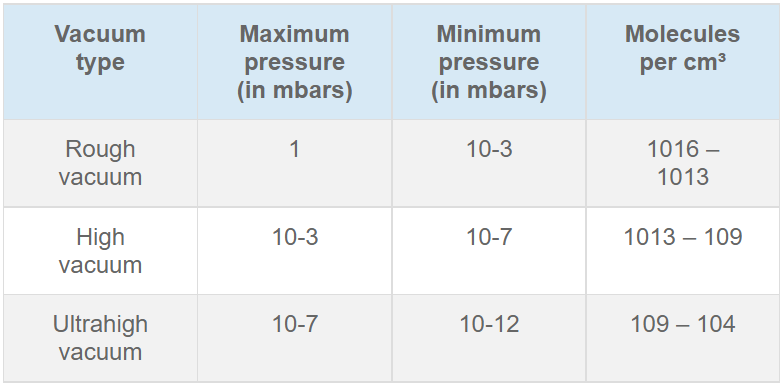
Additionally, you need to consider the following traits:
- The pump’s flow rate: The flow rate of the pump is proportional to the machine’s draining time. As a result, the vacuum pump’s capacity to provide both the needed pumping speed (volume flow rate) and the mass flow rate according to the process requirements must be assessed. In general, the faster the flow rate, the less time it takes to drain. According to the kind of vacuum selected, the number of surviving molecules per cm3 is shown in the table above.
- Chemical compatibility: By examining all conceivable difficulties that the device may meet, you must examine the compatibility of the gasses utilized in your application with the selected vacuum pump.
- Lubrication: It’s critical to consider whether or not lubricating the vacuum pump is necessary. A vacuum pump that is oiled has higher efficiency and resistance. It does, however, need frequent maintenance. A dry vacuum pump is preferred in a laboratory setting.
- Maintenance and cost: The frequency of maintenance cycles will then need to be examined based on the parameters given above. This will establish the total cost of your installation, which will include not only the purchase price but also the expenditures for operation and maintenance.
Applications of Vacuum Pumps
Vacuum pumps are utilized in numerous industrial and scientific processes including composite plastic molding processes, vacuum tubes, production of most types of electric lamps, and CRTs where the instrument is either left evacuated or re-filled with a distinct gas or gas mixture, notably ion implantation, semiconductor processing, dry etch and PVD, PECVD, ALD, and CVD deposition and so on in photolithography, medical processes that require suction, electron microscopy, uranium enrichment, medical applications such as radiosurgery and radiopharmacy, radiotherapy, analytical instrumentation to analyze gas, solid, liquid, surface and bio materials, mass spectrometers to produce a high vacuum between the ion source and the detector, metal and plastics for decoration, vacuum coating on glass, for durability and for energy conservation, such as low-emissivity glass, hard coating for engine components, ophthalmic coating, milking devices and other equipment in dairy sheds, vacuum impregnation of porous products such as electric motor windings or wood, air conditioning service (withdrawing all impurities from the system before charging with refrigerant), trash compactor, sewage systems, vacuum engineering, freeze drying, and fusion research. A vacuum pump creates a low vacuum for dehydration and a high vacuum for oil purification in the field of oil regeneration and re-refining.
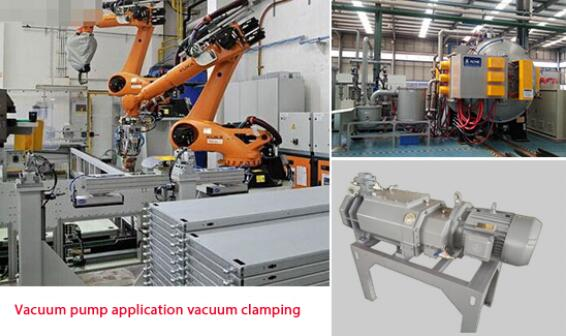
A vacuum can be used to either power or aid mechanical equipment. A vacuum is created by a pump mounted on the engine (typically on the camshaft) in hybrid and diesel automobiles. Instead, in petrol engines, a vacuum is normally formed as a result of the engine’s operation and the flow restriction established by the throttle plate, but it can also be augmented by an electrically powered vacuum pump to increase braking assistance or reduce fuel consumption. This vacuum can then be utilized to power the hydraulic brakes’ vacuum servo booster, the ventilation system’s motors that move dampers, the cruise control servomechanism’s throttle driver, and the door locks and trunk releases.
The vacuum source in an airplane is frequently utilized to power gyroscopes in different flying instruments. The instrument panel is purposefully built with certain instruments powered by electricity and others powered by the vacuum source to prevent complete loss of instrumentation in the case of an electrical failure.
Depending on the application, some vacuum pumps are powered and operated by different methods. They can be electrically driven (utilizing electric current) or pneumatically driven (using air pressure).
Various Techniques of Vacuum Pump
Vacuum pumps are used in a variety of vacuum systems, along with chambers and operating methods. In some cases, more than one pump (in series or parallel) will be employed in a single application. A positive displacement pump that carries a gas load from an intake port to an outlet (exhaust) port can be used to generate a partial vacuum, often known as a rough vacuum. Such pumps can only reach a low vacuum due to their mechanical constraints. Other procedures, generally in sequence, must subsequently be utilized to produce a greater vacuum (usually after a negative displacement pump is used to produce a fast vacuum). An oil-sealed rotary vane pump (the most typical positive displacement pump) might be used to support a diffusion pump, or a dry scroll pump could be used to support a turbomolecular pump. Other combinations exist, depending on the strength of vacuum required.
A high vacuum is difficult to achieve because the outgassing and vapor pressure characteristics of all materials subjected to the vacuum must be carefully examined. Oils, greases, and plastic or rubber gaskets used as vacuum chamber seals, for example, must not boil off when contacted with the vacuum; otherwise, the gasses produced will prevent the appropriate degree of vacuum from being achieved. All surfaces exposed to the vacuum must often be roasted at a high temperature to drive off absorbed gasses.
Desiccation prior to vacuum pumping can also help to prevent outgassing. Metal chambers with metal gasket seals, such as Klein flanges or ISO flanges, are more frequent in high vacuum chamber seals than rubber gaskets, which are more common in low vacuum chamber closures. The system must be clean and devoid of organic debris to reduce outgassing. All materials, solid or liquid, have a low vapor pressure, and when the vacuum pressure goes below this vapor pressure, outgassing becomes critical. As a result, many materials that function well at low vacuums, like epoxy, may be outgassing at higher vacuums. With these safeguards in place, vacuums of 1 mPa may be obtained with a variety of molecular pumps. It is feasible to achieve 1 µPa with proper design and operation.
Pumps of various sorts can be used in series or in parallel. A positive displacement pump would be used to eliminate the majority of the gas from a chamber in a standard pump down sequence, starting at the atmosphere (760 Torr, 101 kPa) and working down to 25 Torr (3 kPa). The pressure would then be reduced to 104 Torr using a sorption pump (10 mPa). A cryopump or turbomolecular pump would be employed to reduce the pressure to 108 Torr (1 Pa). Below 106 Torr, an extra ion pump can be initiated to remove gasses that a cryopump or turbo pump cannot handle, such as helium or hydrogen.
Custom-built equipment, stringent operational procedures, and a fair amount of trial-and-error are often required for ultra high vacuum. Stainless steel vacuum systems with metal-gasketed vacuum flanges are the most common. To temporarily boost the vapor pressure of all outgassing elements in the system and boil them out, the system is normally baked, ideally under a vacuum. This outgassing of the system can also be done at room temperature if required, although it will take significantly longer. The system can be chilled to lower vapor pressures to reduce residual outgassing during real operation once the bulk of the outgassing materials have been boiled off and evacuated. Liquid nitrogen is used to chill some systems deep below room temperature in order to stop residual outgassing while also cryopumping the system.
Some unusual leakage pathways and outgassing sources must be addressed in ultra-high vacuum systems. Aluminum and palladium’s water absorption becomes an intolerable cause of outgassing, and even hard metals like stainless steel and titanium’s absorptivity must be addressed. In severe vacuums, some oils and greases will boil out. It may be necessary to address the porosity of the metallic vacuum chamber walls and the grain direction of metallic flanges.
The influence of molecule size must be taken into account. Smaller molecules are easier to leak in and absorb by specific materials; thus, molecular pumps are less efficient at pumping gases with smaller molecular weights. Although a system may be able to remove nitrogen (the major component of air) to the appropriate vacuum, leftover ambient hydrogen and helium may still be present in the chamber. Outgassing issues arise in vessels lined with a highly gas-permeable material such as palladium (a high-capacity hydrogen sponge).
What are The Main Types of Vacuum Pump?
Vacuum pumps fall into five categories:
- Rotary vane vacuum pumps
- Diaphragm vacuum pumps
- Liquid ring vacuum pumps
- Scroll vacuum pumps
- Turbomolecular vacuum pumps
The sort of vacuum required, as well as the pricing and robustness of the technology required, will influence your vacuum pump selection.
1. Rotary Vane Vacuum Pump
A rotary vane vacuum pump is an excellent choice if you need a high-performance vacuum pump at a reasonable cost.
Rotary vane vacuum pumps are small and compact, with a harsh vacuum capability. They’re especially good for watery samples and solvents that boil quickly. Before they even come in contact with the pump, vapors can be collected.
The operation of rotary vane vacuum pumps necessitates the use of oil. Oil enables perfect airtightness, continual and effective lubrication of the moving components, and great heat dissipation to keep the vacuum pump cool.
Regular maintenance, on the other hand, is necessary to guarantee the pump’s optimal performance. One downside is the requirement to change the oil on a frequent basis in order to limit the possibility of wear. It is suggested that you replace it after 3,000 hours of use.
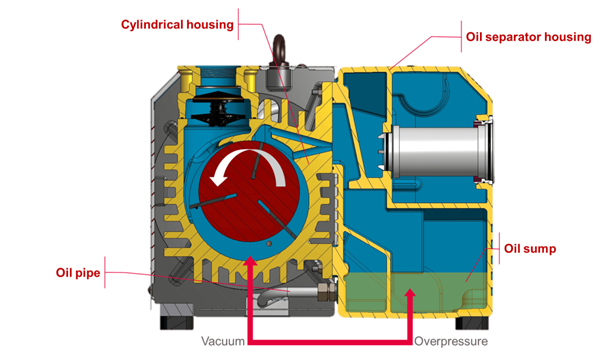
2. Diaphragm Vacuum Pump
Diaphragm vacuum pumps are particularly corrosion and chemical resistant. As a result, they may be utilized with any viscous, acidic, or corrosive substance.
Because of this property, diaphragm vacuum pumps are widely employed in industries such as food (for pumping fluids like water, chocolate, and syrups), cosmetics (for creams and gels), and chemistry. They’re also employed for rotational evaporation and volatile compound treatment. Furthermore, they are well-suited for continual use.
Diaphragm vacuum pumps also have the benefit of being dry pumps. This eliminates the need for oil lubrication, as well as cheaper maintenance expenses than a rotary vane vacuum pump. However, these pumps are somewhat costly to acquire. Another crucial factor to remember is that diaphragm pumps have a lower vacuum level than rotary pumps, making them unsuitable for freeze-drying.
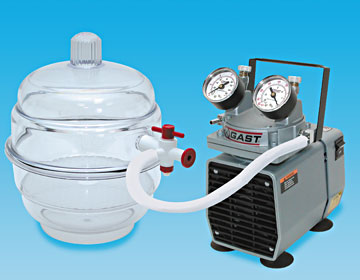
3. Liquid Ring Vacuum Pump
Liquid ring vacuum pumps work by pumping a liquid that is centrifuged against the pump’s walls. As a result, the pump’s airtightness is maintained by a liquid ring.
Distilleries, power plants, petroleum refineries, mines, sugar mills, and other businesses may find liquid ring vacuum pumps beneficial. Liquids, tiny solid particles, and vapors flow through these vacuum pumps with little sensitivity. Furthermore, their isothermal compression is perfect for explosive and heat-sensitive materials, ensuring great safety. Vacuum filtration, moisture extraction, water removal from the pulp during paper production, mineral recovery, and ash management are all possible applications for liquid ring vacuum pumps.
These strong pumps can decrease and boost pressure with a maximum flow rate of 30,000 m3/h. Nonetheless, we suggest that you pay attention to the liquid ring’s saturated vapor pressure. The vacuum pump’s minimum pressure must not be lower than the liquid ring’s saturation pressure, otherwise the liquid ring will evaporate. This will affect the airtightness of your vacuum pump.
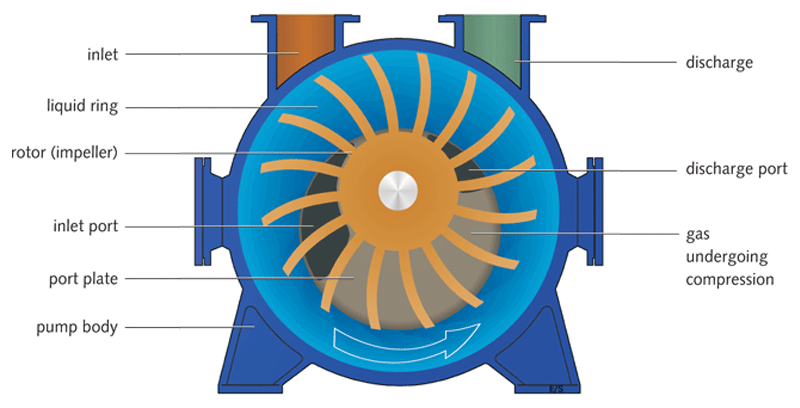
4. Scroll Vacuum Pump
Scroll vacuum pumps are used to pump vacuum both wet and dry. As a result, they’re commonly employed in research and laboratories.
Scroll vacuum pumps pump and compress liquid or gaseous media using two spiral-shaped scrolls. One spiral is stable, while the other rotates eccentrically around it. The gas may be squeezed because of this eccentric movement.
Scroll vacuum pumps are small, silent, and don’t require any oil. The joint spiral creates the airtightness of the vacuum pump. The seal must be replaced often to preserve ideal airtightness, hence regular maintenance is required. The primary problem with these pumps is that they are susceptible to dirt and foreign particles, which can corrode the spiral seal.
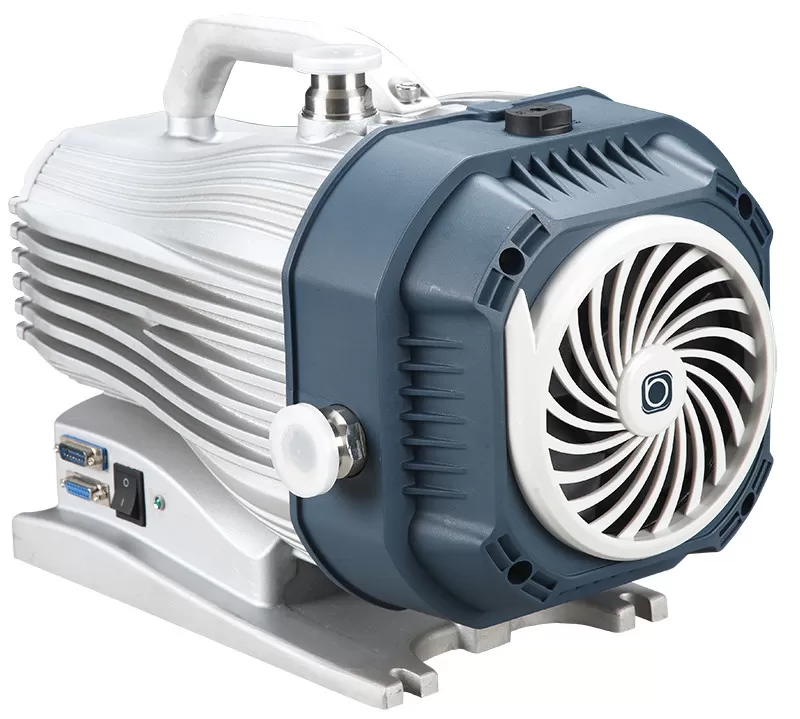
5. Turbomolecular Vacuum Pump
Turbomolecular vacuum pumps can reach pressures of up to 12 mbar. The flow rates range from 50 to 5,000 liters per second. They work in the same way compressors do. An electric motor operating at high speed rotates the blades of the various levels of the pump, removing the air from the volume to be evacuated. To accommodate high spinning speeds, these pumps are frequently installed on magnetic bearings. They must have the main pump that can reach a vacuum of 10-2 mbar.
The benefit of turbomolecular vacuum pumps is that they do not require any oil. As a result, they are spotless pumps. These pumps are ideal for applications requiring ultrahigh vacuum, such as analytical instruments or laboratory analysis.
These pumps are more expensive to buy and maintain than standard vacuum pumps because of their complicated technology. Pumping speed is also influenced by the type of gas that is being pumped. For lighter gasses, the speed reduces dramatically.
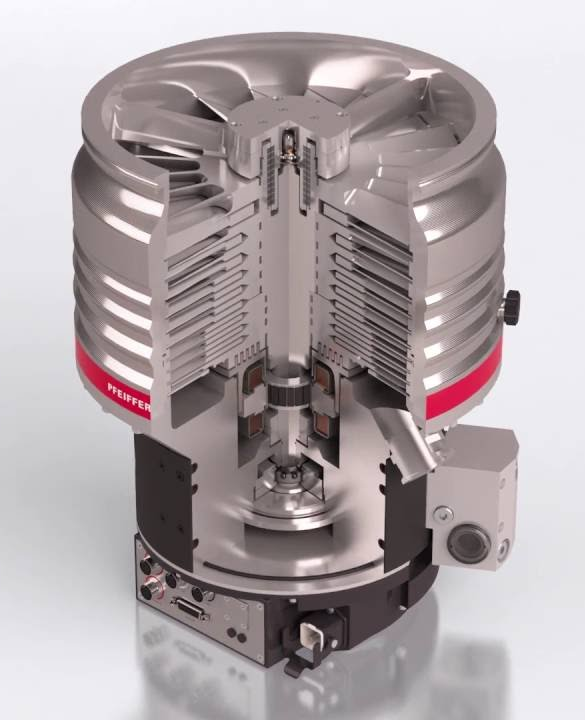
What is the Difference Between a Lubricated Vacuum Pump and a Vacuum Pump Without Oil?
Another factor that will impact your decision is the vacuum pump’s lubrication. Whether or not you need to oil a vacuum pump affects the machine’s maintenance level.
Lubricated vacuum pumps are more durable and efficient although they require routine maintenance every 12 hours or so. A cold trap is also recommended, as the oil tends to condense steam and reduce the pump’s capacity. This device, which is attached to the pump’s input, keeps oil vapor from rising over the vacuum level. If you don’t have a cold trap, we recommend checking the color of the oil used to lubricate the vacuum pump on a regular basis. Another downside of lubricated vacuum pumps is that they are not suitable for use in some industries, such as the food business, because the oil may contaminate the food.
Vacuum pumps that do not use oil are known as dry vacuum pumps. As a result, there is no chance of the lubricating material contaminating the product. If you operate in the agri-food business, dry vacuum pumps are especially suggested. These vacuum pumps, on the other hand, are more susceptible to moisture, and because there is no cooling liquid, they are more susceptible to high temperatures.
What Are the Main Components of a Vacuum Pump?
At the back is the electrical motor, at the front is the compressor, on the top is a handle and at the bottom is the support base. It also has an inlet that connects to the system so that air can be taken out of the system, and it also has an exhaust so that air can be dispersed to the environment.
Conclusion
Vacuum pumps are one of the most critical, if not the most important, components found in vacuum furnaces. How these systems work determines the operations we conduct and the quality we attain. Although many types of vacuum pumps have been briefly explained here, a more in-depth examination of each is required to properly comprehend the benefits and drawbacks of each technology. You are also encouraged to visit Vacuum Pump for sale to find an appropriate instrument based on your requirements.
FAQs about Vacuum Pump
1. What Type of Pump Is a Vacuum Pump?
Primary (Backing) Pumps, Booster Pumps, and Secondary (High Vacuum) Pumps are the different types of pumps for these vacuum ranges: Vacuum pressures in the high, very high, and ultra-high categories. Vacuum pumps are divided into two types: gas transfer pumps and entrapment or capture pumps.
2. What is a Vacuum Pump Commonly Used For?
Simply put, vacuum pumps are mechanical devices that allow air and gas molecules to be removed from a sealed compartment to create an air- and/or gas-free environment. Their primary function is to clean and seal. Depending on the medium being pushed through them, vacuum pumps are available in wet or dry versions.
3. What is a two stage Vacuum Pump?
A two-stage design uses two rotors and vanes. As a result, the first stage creates a vacuum, while the second cleans the system, resulting in a higher final vacuum level. As a result, two-stage pumps may achieve higher vacuum levels than single-stage pumps.
4. What is CFM In a Vacuum Pump?
Let’s start by defining each phrase. The amount of air moving through a vacuum system is measured in CFM (Cubic Feet per Minute). The air flow rate is measured in cubic feet per minute (CFM). The top speed of an automobile is measured in CFM. The vacuum’s ultimate power is measured by a suction lift.
5. Can a Centrifugal Pump Create a Vacuum?
There are two modes of operation for a self-priming centrifugal pump: priming and pumping. In priming mode, the pump functions similarly to a liquid-ring pump. The revolving impeller produces a vacuum at the ‘eye’ of the impeller, which sucks air from the suction line into the pump.
What Are the Main Components of a Vacuum Pump?
At the back is the electrical motor, at the front is the compressor, on the top is a handle and at the bottom is the support base. It also has an inlet that connects to the system so that air can be taken out of the system, and it also has an exhaust so that air can be dispersed to the environment.
Download Types of Vacuum Pump PDF
Buy Equipment or Ask for a Service
By using Linquip RFQ Service, you can expect to receive quotations from various suppliers across multiple industries and regions.
Click Here to Request a Quotation From Suppliers and Service Providers
Read More on Linquip
- 6 Main Types of Dynamic Pumps: Examples + PDF
- 3 Types of Oil Pumps + Working Principle & PDF
- 5 Main Types of Fuel Pump & How They Works?
- 3 Types of Vane Pumps: Working Principles & Application
- 3 Types of Heat Pump + Working Principle ( Clear Guide)
- 3 Types of Positive Displacement Pump + Name & PDF
- 3 Types of Well Pumps + Applications
- Types of Piston Pumps
- A Cheat Sheet For The Types of Pump Couplings
- Different Types of Pumps: Ultimate Guide in 2022
- Types of Centrifugal Pumps: All Classification & Working Principles
- Different Types of Hydraulic Pumps: a Complete Guide
- 5 Types of Vacuum Pump and Applications + PDF
- 9 Different Types of Rotary Pumps + PDF
- 5 Types of Concrete Pumps + PDF
- 6 Type of Sump Pump and Which Are Better to Buy?
- Types of Pump Casings (In Centrifugal Pumps & Others) + Pros & Cons
- Types of Water Pumps and Their Principles
- Types of Submersible Pumps: All Classification With Details
- Types of Centrifugal Pumps: All Classification & Working Principles
- 10 Parts of Hydraulic Pump + PDF & Function
- Working Principles of Hydraulic Pump (With Videos)
- Hydraulic Pump Working Principles: Ultimate Guide
- What is Hydraulic Pump: Learn The Basics, Boost Your Knowledge
- The 5 Best Air Source Heat pump in 2022 (Clear Guide)
- 7 Best RV Water Pump In 2022 (Clear Guide & Review)
- The 10 Best Electric Air Pump in 2022 (Clear Guide)
- 9 Different Types of Rotary Pumps + PDF
- The Best HVAC Vacuum Pump in 2022 (Clear Guide)

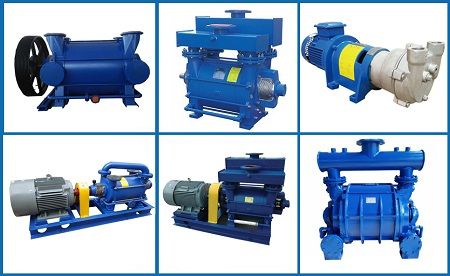


i like your blog
What a wonderful thing you’ve done by telling us about your journey! To locate hundreds of different types of industrial equipment for your specific use and requirement, you may also explore our industrial directories.
i like your website
Thanks for visiting our website and leaving your comment! You are encouraged to visit Linquip Tech News, where you can find similar posts.
I Really appreciate your Blog, because it is long with more information, and because you have shared what others are not sharing. I find your content to be the only one with clear sentences that is both informative and easy to understand.
Thanks for visiting our website and leaving your comment! You are encouraged to visit Linquip Tech News, where you can find similar posts.
Very Nice Blog Provide Good Knowledge About Vacuum Pump.
Thanks for visiting our website and leaving your comment, Bipin! We hope to hear from you again in our other posts.
nice work intricing blog
Your insight is much appreciated. Our industrial directories have hundreds of distinct pieces of machinery for sale, so you may get exactly what you need for your specific industry.
Your blog is very informative. In this blog you explain the liquid pump in very detail.
Shikha, we appreciate you taking the time to check out our site and share your thoughts. If you enjoy our content, please share them and comment again.
Thank you for sharing this Amazing info.
Thanks for visiting our website and leaving your comment, Shanti! You are encouraged to visit Linquip Tech News, where you can find similar posts.
Send products catalog and profile pic
It was a helpful explanation when you told us that the basic operating principle of a vacuum pump is to remove air molecules and other gasses from the vacuum chamber, which is why it is important to consider the pump’s capacity and flow rate along with its chemical compatibility when choosing what vacuum pump to get for your application. My brother recently invested in a beer brewery, so now he needs a vacuum pumping system in his factory for their business operations. I’ll have to help him find a trusted industrial supplier to contact about the explosion-proof vacuum pumps he needs for his brewery soon.